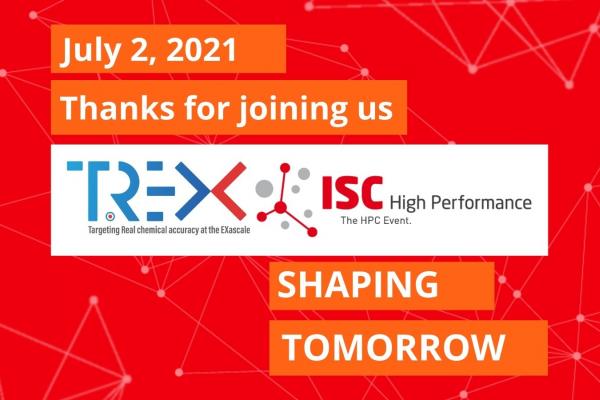
TREX at the PRACE virtual booth at ISC2021 Digital Highlights
ISC High Performance 2021 Digital was undeniably the largest virtual community get together, with over 2000 international attendees and 84 exhibitors, for high performance computing (HPC), machine learning (ML) and high performance data analytics (HPDA) this year.
On 2 July, TREX - Targeting Real Chemical Accuracy at the Exascale participated in the PRACE virtual booth at ISC2021 with the support of the FocusCoE, giving short presentations coming from other HPC CoEs.
The TREX European Centre of Excellence focuses on high accuracy quantum mechanical methods, essential in many different fields of application such as new material design or photochemistry, showcasing the innovative view of HPC usage applied to Quantum Monte Carlo simulations.
Among these methods, Quantum Monte Carlo (QMC) approaches are particularly well adapted to exascale architectures. Its ambition is to help the community take advantage of exascale machines through the use of the TREX HPC software.
The presentation and key takeaways
The event is vivid evidence of the strategic importance of these technologies for discovering the latest updates about the pan-European HPC infrastructure.
The TREX presentation exhaustively showcased the innovative view of HPC usage applied to Quantum Monte Carlo simulations and gathered over 30 HPC experts from around the globe.
The presentation was started by Anthony Scemama, an HPC expert and research engineer at the CNRS and currently one of the scientific work package (WP) leaders within TREX, who provided an exhaustive overview of the project and its goals federating European scientists, high performance computing stakeholders, and SMEs to develop and apply high-performance software solutions for quantum mechanical simulations at the exascale.
During the presentations other TREX team members such as Pablo de Oliveira Castro (an assistant professor at the University of Versailles Saint Quentin), Cédric Valensi (expert engineer and postdoctoral researcher at the University of Versailles Saint Quentin), and William Jalby (professor at the University of Versailles Saint Quentin) presented the progress review along with the following TREX libraries, making codes ready for exascale.
- TREXIO: A common I/O library and file format for easily exchanging data between applications, facilitating high-throughput computing workflows,
- QMCkl: A library of computational kernels specific to QMC applications written together by QMC and HPC experts, taking advantage of both CPUs and GPUs,
- An integrated workflow including performance analysis (MAQAO) and numerical accuracy measurements (Verificarlo) to be used for the development of QMC kernels and more generally for improving the applications. In particular, the plan is to identify the best performance usage of QMCkl and also to adjust the performance with numerical precision requirements.
 Within the TREX project, state-of-the-art programs for quantum Monte Carlo (QMC) calculations are analysed to identify key algorithms to be then implemented in a human-readable, open-source software QMCkl library. The library is further optimized for future exascale supercomputers by computer scientists of the TREX project. The QMC codes within TREX are at different stages of software development but are all algorithmically extremely advanced and uniquely powerful in the landscape of electronic structure methods.
Within the TREX project, state-of-the-art programs for quantum Monte Carlo (QMC) calculations are analysed to identify key algorithms to be then implemented in a human-readable, open-source software QMCkl library. The library is further optimized for future exascale supercomputers by computer scientists of the TREX project. The QMC codes within TREX are at different stages of software development but are all algorithmically extremely advanced and uniquely powerful in the landscape of electronic structure methods.
These codes will be fully integrated with the TREX software platform as inter-operable autonomous tools that can be readily interfaced with each other and with the optimized exascale-enabling QMCkl library. The computational kernels of the QMCkl library will be used by all QMC codes via a common application programming interface (API).


